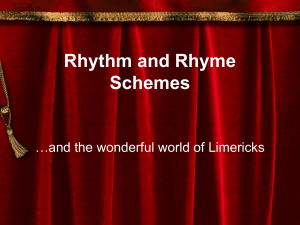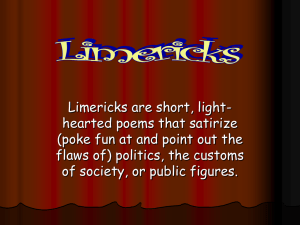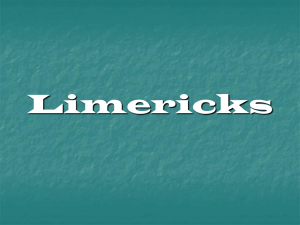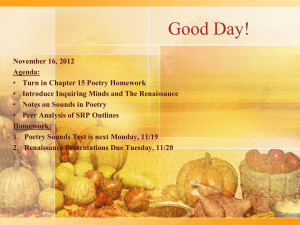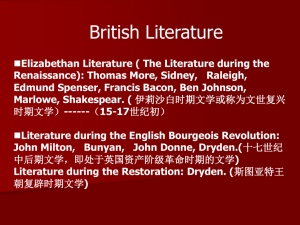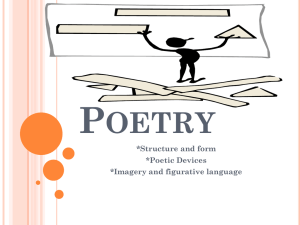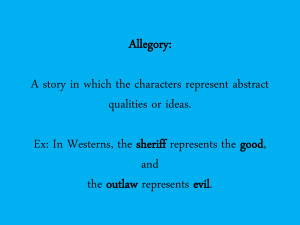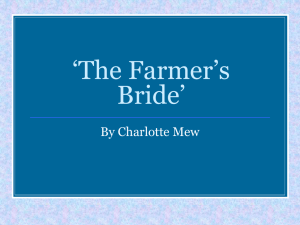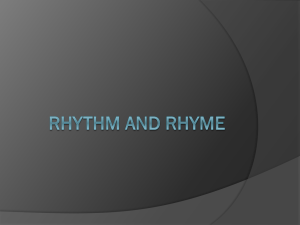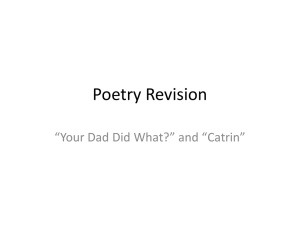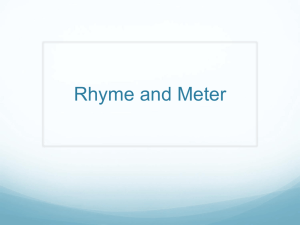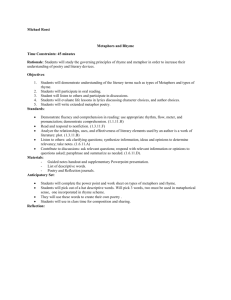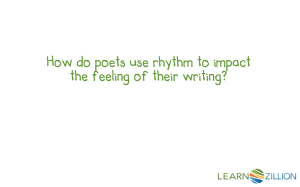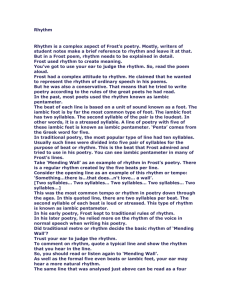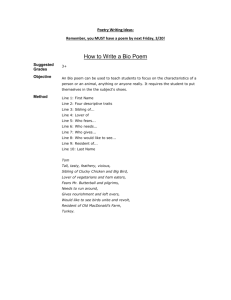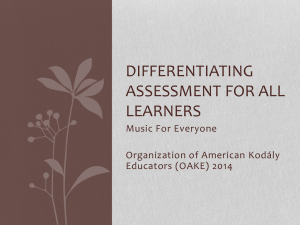RhymeandRhythm_000
advertisement
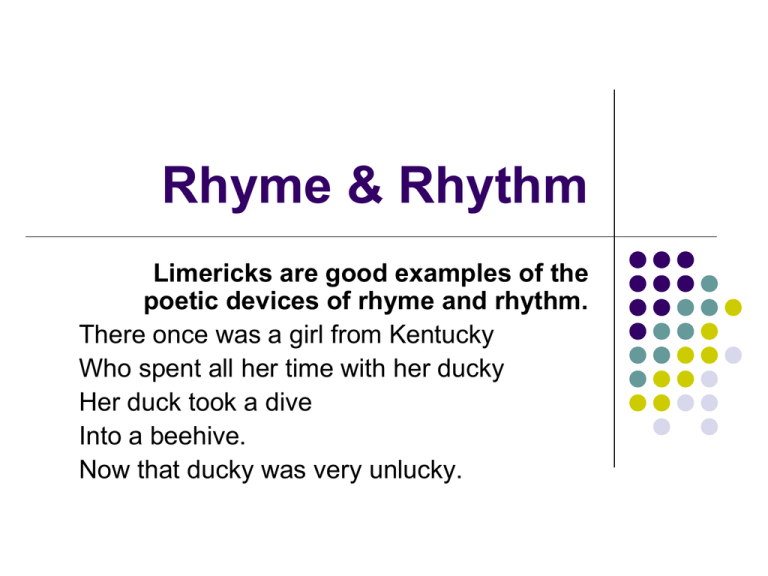
Rhyme & Rhythm Limericks are good examples of the poetic devices of rhyme and rhythm. There once was a girl from Kentucky Who spent all her time with her ducky Her duck took a dive Into a beehive. Now that ducky was very unlucky. Rhyme is the repetition of end sounds in words. For example: Bump - jump wall - ball talk – hawk girl - curl End rhymes appear at the end of two or more lines of poetry. For example: The gingham dog and the calico cat Side by side on the table sat. The Duel Eugene Field Another example of end rhyme: The pig, if I am not mistaken, Supplies us with sausage, ham, and bacon. Let others say his heart is big I call it stupid of the pig. The Pig Ogden Nash One more example: Behold the duck. It does not cluck. A cluck it lacks. It quacks. It is specially fond Of a puddle or pond. When it dines or sups, It bottoms ups. The Duck Ogden Nash Internal rhymes appear within a single line of poetry. For example: Abednego was meek and mild; he softly spoke, he sweetly smiled. He never called his playmates names, and he was good in running games; But he was often in disgrace because he had a dirty face! Daniel and Dago were a pair who acted kindly everywhere; They studied hard, as good as gold; they always did as they were told; They never put on silly airs, but they took things that were not theirs. When Festus was but four year old, his parents seldom had to scold; They never called him “Festus, don’t”; he never whined and said “I won’t”. Yet it was sad to see him dine. His table manners were not fine. An Alphabet of Famous Goops Gelett Burgess Another example of internal rhyme: Phrases from The Raven Once upon a midnight dreary, while I pondered, weak and weary, While I nodded, nearly napping, suddenly there came a tapping, Doubting, dreaming dreams no mortal ever dared to dream before; Open here I flung the shutter, when, with many a flirt and flutter, Nothing further then he uttered—not a feather then he fluttered— Startled at the stillness broken by reply so aptly spoken, What this grim, ungainly, ghastly, gaunt and ominous bird of yore The Raven Edgar Allen Poe Rhyme scheme refers to the pattern of end rhymes in a poem. Letters are used to identify a poem’s rhyming pattern. The letter a is placed after the first line and all lines that rhyme with the first line. The letter b identifies the next line ending with a new sound and all lines that rhyme with it. Letters continue to be assigned in sequence to lines containing new ending sounds. For example: Old Mother Hubbard Went to the cupboard To get her poor dog a bone But when she came there The cupboard was bare, And so the poor dog had none. (a) (a) (b) (c) (c) (d) As a class, find the rhyme scheme for the poems on your worksheet. Limerick Partner Activity: Find a partner and complete the worksheet about a famous limerick. Now do the Meter 1 and Meter 2 worksheets. When you have finished and corrected them, continue with this Powerpoint. Rhythm: the pattern of beats or stresses in language. The pattern can be regular or random. Prose and free verse poetry display random patterns of beats. Meter: the regular pattern of stresses found in many poems and songs. Rhythm serves many purposes. It helps create mood by being fast or slow, calm or frenzied, for example. It can imitate action or emphasize a meaning or emotion. Rhythm is often combined with rhyme, alliteration, and other poetry devices to add a musical quality to a work. Poetry scholars use symbols to indicate patterns of rhythm. For an unstressed syllable, this is used: For a stressed syllable, this is used: To figure out the rhythm or pattern of a poem, it is marked like this: In this poem “Annabel Lee” by Edgar Allan Poe, every other line has the same number of stressed syllables. In general, there is a pattern within every line of the poem: two unstressed syllables, then a stressed one, and so on. Note: lines 1 and 5 have exactly the same pattern of stressed and unstressed syllables. The musical quality created by the rhythm in poetry is best appreciated when heard. Read these two poems aloud to get a feel for their rhythms. If you can hear a clear beat, the poem has a regular meter. If you cannot, it demonstrates an irregular or random rhythm. Circle your answer. There is no frigate like a book To take us lands away, Nor any coursers like a page Of prancing poetry. There is No Frigate Like a Book Emily Dickinson Along the northern coast, Just back from the rock-bound shore and the caves, In the saline air from the sea in Mendocino country, Song of the Redwood Tree - Leaves of Grass Walt Whitman Limericks are humorous poems, five lines long, that always take the same form. The 1st, 2nd, & 5th lines usually have 8 or more syllables. The 3rd & 4th lines usually have 5-7 syllables. Limericks have a rhythm that comes from the arrangement of stressed and unstressed syllables. Here’s an example: What is the rhythm pattern for a limerick? How many syllables are in each line? Here’s a couple more limericks: What is the rhyming pattern for a limerick? When writing a limerick, try this helpful website: http://www.rhymezone.com/ There was an old man of Blackheath Who sat on his set of false teeth Said he, with a start, “O Lord, bless my heart!” I have bitten myself underneath! Remember to make your limerick humorous!
